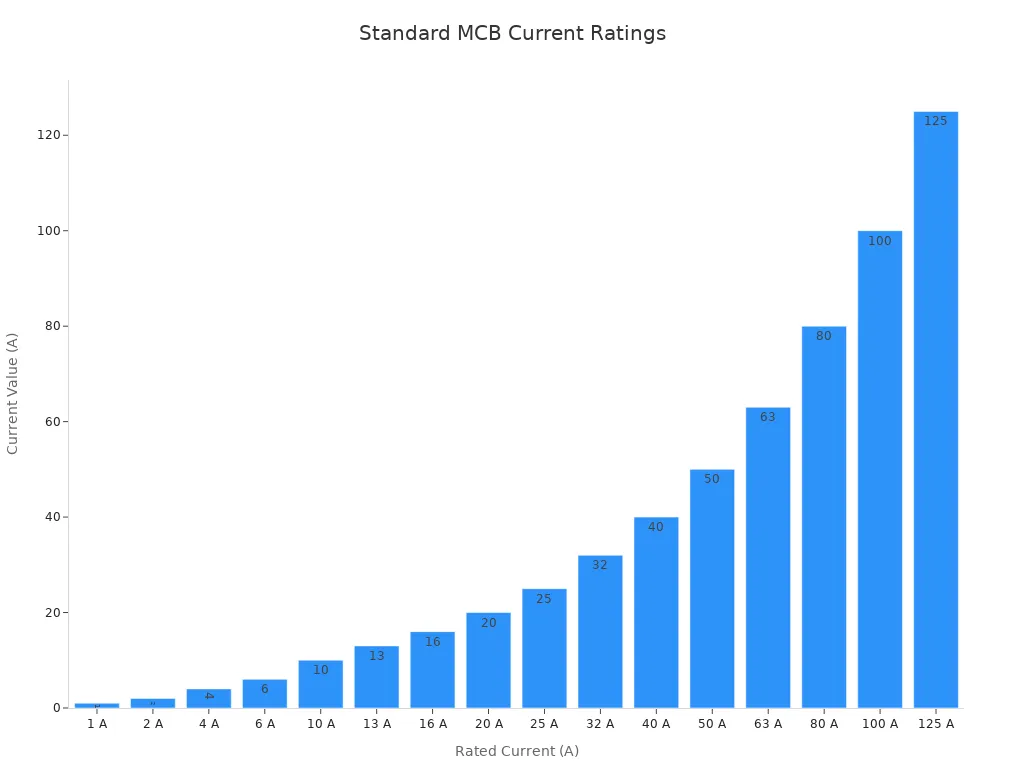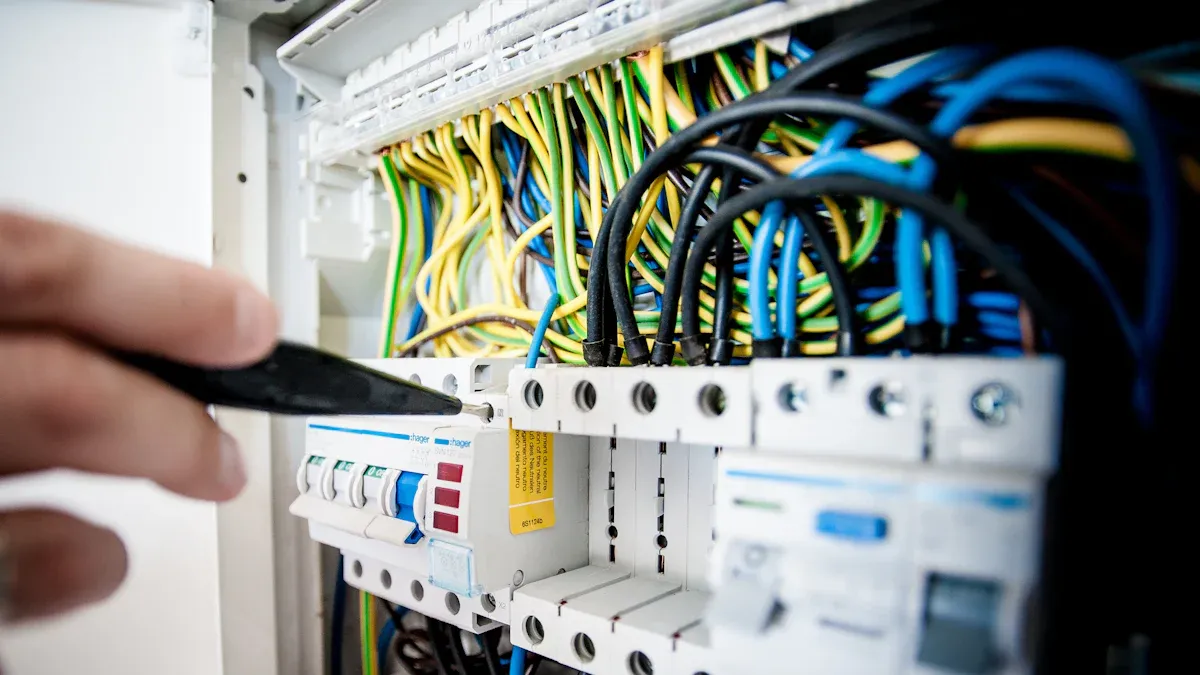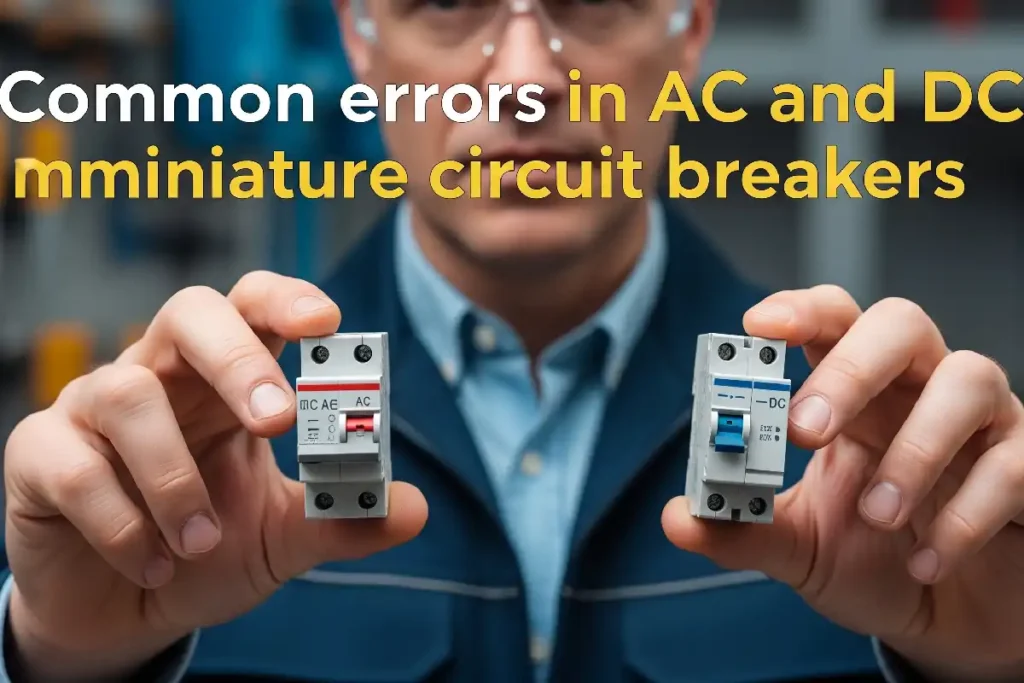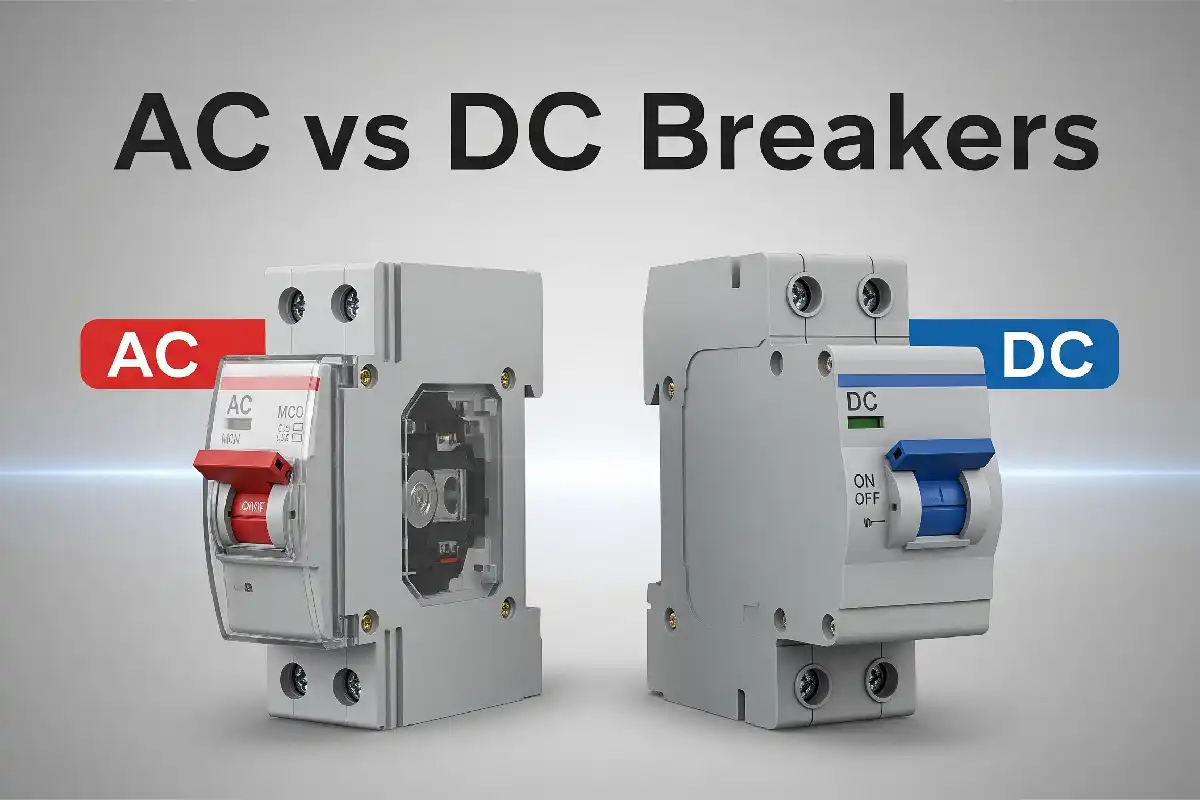You need to use the correct breaker for your system. AC and DC miniature circuit breakers are not the same. You should read the manufacturer’s instructions. You must also follow local electrical rules to stay safe.
UL 489-certified breakers protect main circuits very well. UL 1077 models are good for devices.
People often pick the wrong breaker or mount it badly. Some forget to check and fix breakers often. You can stop expensive mistakes by following safety steps. Label each circuit and test breakers after you put them in.
Key Takeaways
- Always pick the right breaker for your system. Use AC breakers for alternating current. Use DC breakers for direct current. This helps stop fires and keeps equipment safe.
- Look at breaker labels before you buy or install them. Check the voltage and current ratings. Make sure they have the right certifications. This keeps things safe and working well.
- Put in breakers with care. Use the correct wire size. Mount them securely. Make sure all connections are tight. This stops overheating and keeps breakers from tripping too much.
- Choose the right breaker size for your system. Match the load current. Follow safety rules. This protects your system and stops annoying trips.
- Check and take care of breakers often. Test them and clean them. Tighten wires and change broken parts. This keeps your electrical system safe and working well.
AC vs DC Breakers
Key Differences
It is important to know how AC and DC miniature circuit breakers are different. You cannot swap them. Each one is made for a certain kind of current.
- AC miniature circuit breakers work with alternating current. People use them in homes and offices. They protect lights and appliances in electrical panels.
- DC miniature circuit breakers are for direct current. You see them in solar panel systems and battery banks. Some industrial machines use them too. They can handle higher voltages and currents, up to 1500 V DC.
| Breaker Type | Typical Rated Voltage | Typical Rated Current | Common Use Cases |
|---|---|---|---|
| AC MCB | Up to 1,000 V AC | Up to 125 A | Homes, offices, lighting |
| DC MCB | Up to 1,500 V DC | Up to 6300 A | Solar, batteries, industry |
Tip: Always look at the voltage and current ratings on the breaker label. Using the wrong breaker can cause overheating, fire, or equipment problems.
If you put an AC breaker in a DC circuit, it might not trip when there is a problem. This can make dangerous arcs and even start a fire. DC breakers are built to handle direct current safely.
Polarity and Arc Extinguishing
Polarity is very important in DC circuits. Some DC miniature circuit breakers, like the Langir JB model, do not care about wire direction. You can connect positive and negative wires either way. This helps protect your system if you switch the wires by mistake.
AC breakers do not need this because alternating current changes direction on its own. In DC, the current only goes one way. The breaker must be able to handle reverse currents.
Arc extinguishing is another big difference. AC breakers use the natural zero-crossing of the current to stop arcs. DC breakers have a harder job. The current does not drop to zero, so arcs last longer. DC breakers use magnetic blow-out coils and special chambers to stretch and cool the arc until it stops.

If you use the wrong breaker, you can get long-lasting arcs. These arcs can hurt your equipment or start a fire. Always use the right breaker for your circuit to keep things safe.
Common Mistakes
Wrong Breaker Type
Not all miniature circuit breakers work the same. Many people think they do, but that is wrong. Using the wrong type is a big mistake. AC and DC miniature circuit breakers have different jobs. If you use an AC breaker in a DC circuit, it might not trip when needed. This can make dangerous arcs or even start fires. DC breakers are made to handle direct current safely. They have special arc extinguishing parts. Always look at the label for voltage and current ratings before you put in a breaker. Make sure the breaker fits your system.
Tip: Do not guess about breakers. Always use the right breaker for your circuit—AC for alternating current, DC for direct current.
Installation Errors
Bad installation can cause big safety problems. You must use the right wire size, mount the breaker right, and make good connections. Here are some common mistakes:
- Wires that are too thin can get hot and may start a fire.
- If the wire is too small, you might see voltage drops and things may not work.
- Breakers may trip a lot if the wire cannot handle the load.
- If you do not mount the breaker right, it can break or not close.
- Loose or weak connections can make the breaker trip, overheat, or lose voltage.
Always pick the right wire size for your load. Tighten all connections as the maker says. Mount the breaker well so it works right.
Overload and Sizing Issues
Picking the wrong breaker size can cause problems. The breaker may trip too much or not protect your system. You must size your breaker for your load and follow the rules. Here is how you do it:
- Write down voltage, load current, number of poles, trip type, and extra features.
- Pick the right shape and connection for your setup.
- Think about the place you will use it and safety rules.
- Choose the breaker type (thermal or magnetic) you need.
- Use derating. The NEC 80% rule says the breaker should be at least 125% of the load.
- Pick a breaker that matches your load and meets all rules.
For example, if your load is 24A, divide by 0.8 to get 30A. Use a 30A breaker. If your load is 28A, multiply by 1.25 to get 35A. Always match the breaker to the wire and voltage.
Note: If the breaker is too big, it may not trip when needed. If it is too small, it may trip too much.
Maintenance Neglect
You need to check your breakers often. Many people forget to do this. Dust, loose wires, or old parts can make breakers fail. Here are some tips:
- Look for damage or signs of overheating.
- Test breakers by turning them on and off.
- Use a multimeter to check for good flow and resistance.
- Tighten all wires and check for loose ones.
- Change any breaker that will not reset or trips for no reason.
Checking your breakers helps you find problems early and keeps things safe.
Compliance Oversights
Not following the rules can cause big problems. Insurance companies want all work to meet local codes and be done by pros. If you do not follow the rules, you risk:
- Losing insurance if there is a fire or accident.
- Paying a lot for repairs, doctor bills, or lawyers.
- Getting fined for breaking the rules, sometimes a lot of money.
- Getting sued if someone gets hurt or something is damaged.
- Paying more for insurance or losing it.
Always follow local codes and use certified AC and DC miniature circuit breakers. If you are not sure, hire a pro to install them.
Alert: Not following the rules can mean no insurance and legal trouble. Always follow the rules to keep yourself and your stuff safe.
Selecting AC and DC miniature circuit breakers

Selection Checklist
Picking the right miniature circuit breaker keeps your system safe. Use this checklist to help you choose:
- Identify the type of load
- Type B is for things like heaters or bulbs.
- Type C or D is for motors or transformers with big starting currents.
- Type Z is for sensitive electronics.
- Determine the normal operating current (Ib)
- Pick a breaker with a rated current that is the same or a little higher than the normal current.
- Check the cable’s current capacity (Iz)
- Make sure the breaker’s rated current is not more than the cable can handle.
- Assess short-circuit current
- The breaker must be able to stop the biggest fault current.
- Match tripping characteristics
- Choose a trip curve that fits your load and stops false trips.
- Confirm the number of poles
- The breaker should have enough poles for all the wires you want to protect.
- Check voltage and amperage ratings
- The breaker must work with the circuit’s voltage and current.
- Verify certifications and standards
- Look for marks like UL or IEC/EN 60898-1, or others in the table below.
| Certification Mark / Standard | Description |
|---|---|
| UL Certification Mark | Meets UL safety and performance rules. |
| IEC/EN 60898-1 | International rule for MCBs. |
| Class CTL Marking | Works with Class CTL panelboards. |
| Current Limiting Mark | Limits current during faults. |
| Temperature Mark (e.g., 40°C) | Shows the temperature rating. |
Tip: Always check the breaker’s label for ratings and marks before you buy or use it.
Installation Tips
Good installation helps your breaker work well and last longer. Follow these steps for both AC and DC miniature circuit breakers:
- Turn off all power
- Use a multimeter to make sure the circuit is off.
- Mount the breaker securely
- Snap it onto a DIN rail or panel.
- For DC breakers, mount it up and down for better cooling.
- Connect wires correctly
- For AC, connect hot, neutral, and ground wires to the right spots.
- For DC, watch the polarity. Connect the positive wire from the power to the input, and the positive wire from the load to the output.
- Tighten all screws as the maker says.
- Double-check connections
- Make sure all wires are tight and in the right place.
- Wrong polarity in DC breakers can cause problems or fire.
- Test the breaker
- Turn the power back on.
- Use a device or light to see if the circuit works.
- Trip the breaker by hand to make sure it resets and protects.
- Label everything
- Use strong labels to show what each breaker protects.
⚠️ Alert: Always follow the maker’s datasheet and markings. Many DC breakers care about polarity and need careful wiring.
Maintenance Guide
Checking your breakers often keeps them working well and helps them last longer. Here’s how to take care of your AC and DC miniature circuit breakers:
- Inspect annually
- Check all breakers once a year. In busy or important places, check more often.
- Look for warning signs
- Watch for overheating, color changes, rust, or water damage.
- Listen for buzzing or crackling.
- Smell for burning.
- Check for breakers that trip a lot or have stiff handles.
- Test operation
- Trip and reset each breaker by hand to make sure it works.
- Check connections
- Tighten any loose terminals.
- Use a multimeter to check resistance and current flow.
- Clean and label
- Remove dust and dirt.
- Replace faded or missing labels.
- Replace damaged breakers
- Change any breaker that is worn out, broken, or will not reset.
Note: If you can, use infrared thermography to find hot spots before they get worse.
By doing these steps, you help your AC and DC miniature circuit breakers protect your system for a long time.
You can keep your electrical system safe if you follow some simple steps. Pick the right breaker for what you need. Put in each breaker carefully and check every connection. Check your system often so you can find problems early.
- Plan regular checks and follow local rules to stop dangers.
- Use the right wires, grounding, and safety tools so things work well.
- Get licensed experts to do the work so it is done right and follows the rules.
Doing these things helps protect your home and keeps people safe.
If you need to purchase DC circuit breakers and AC circuit breakers, you can contact us to provide you with the best solution
FAQ
What happens if you use an AC breaker in a DC circuit?
If you use an AC breaker in a DC circuit, it may not trip during a fault. This can cause overheating or fire. Always use a DC-rated breaker for direct current systems.
How do you know if a breaker is AC or DC?
Check the label on the breaker. You will see voltage and current ratings. Look for “AC” or “DC” markings. If you cannot find them, check the manufacturer’s datasheet.
Can you install a miniature circuit breaker yourself?
You can install a breaker if you know electrical safety rules. Turn off all power first. Follow the manufacturer’s instructions. If you feel unsure, call a licensed electrician.
How often should you check your miniature circuit breakers?
You should inspect your breakers at least once a year. Look for signs of damage, loose wires, or overheating. Test each breaker to make sure it works.
What should you do if a breaker trips often?
Tip:
First, unplug some devices to reduce the load. If the breaker still trips, check for wiring problems or damage. Replace the breaker if it feels hot or will not reset. Call a professional if you cannot find the problem.
See also
How to Choose the Right Molded Case Circuit Breaker
Understanding DC Miniature Circuit Breakers for Beginners
How to Choose a Solar DC MCB for Maximum Protection
DC Circuit Breaker Solutions for Safe and Efficient Solar Power
What Miniature Circuit Breakers Do and Where to Find Them





